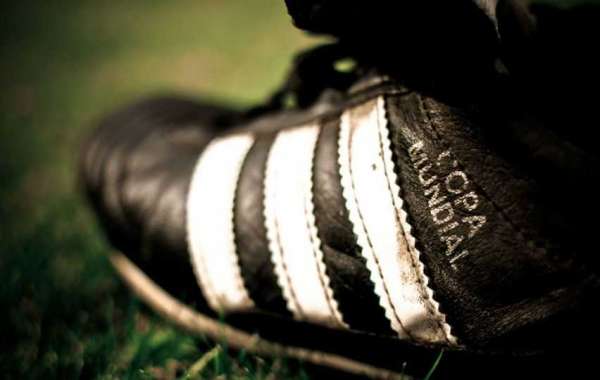While it might have been abandoned slacking different games in embracing video arbitrators and objective line tech - despite the fact that we have seen a great deal of this at the 2018 Russia World Cup - with regards to cutting edge footwear the lovely diversion drives the way.
From ultra-lightweight uppers for expanded speed, to streamlined studs for more noteworthy grasp, the present football boots brag the kind of building you'd hope to discover in the flight business.
Be that as it may, how did humble footy spikes turned out to be such mechanical wonders? Beneath we diagram the progression of the football boot - from their cause as up-cycled workwear to the hello tech kicks being brandished by any semblance of Ronaldo and Messi in Russia this mid year.
Primary picture credit: Niek Beck
The Pre-stud years
While more noted for his various spouses as opposed to his favor footwork, the primary at any point recorded reference to football boots are by the by from a stock of Henry VIII's garments when he kicked the bucket in 1547. Planned by regal shoemaker Cornelius Johnson and costing four shillings, the thick cowhide boots were said to have been lower leg high and to a great degree overwhelming.
As the diversion advanced throughout the following 300 years from the severe, relatively heedless hoofing of an overwhelming pig skin around a field without objectives or markings of Tudor circumstances, to a more composed game with principles and competitions, so did the footwear requests of those playing the amusement.
Old football boots (credit: National Football Museum)
Old football boots from the nineteenth Century (credit: National Football Museum)
With the amusement developing in prominence crosswise over Britain amid the mid-nineteenth Century, assembly line laborers started altering their since quite a while ago bound, steel toe-topped work boots to enhance their hold on sloppy playing surfaces, frequently pounding tacks and nails into them. While these proto-studs enhanced the players adjust and balance, they unavoidably caused genuine wounds for any player on the less than desirable end of a loathsomeness rush from a rival.
The act of stopgap grasps was in the long run banned by the recently settled Football Association in 1863, with the FA announcing that: "Nobody wearing anticipating nails, press plates or gutta percha on the bottoms of his boots is permitted to play."
The brand visit
By the start of the twentieth century, the interest for directed footwear saw various sportswear brands we perceive today like Gola and Hummel start to develop as creators of studded football boots. One such organization to enter the market as of now was the Dassler Brothers Shoe Factory.
Early Dassler boot
Early Dassler boot (credit: Adidas)
Best known for olympic style sports wear (the German organization's athletic spikes were worn by Jesse Owens at the 1936 Berlin Olympic Games no less), before the finish of WWII the plant had turned out to be one of driving brands for football boots.
A contradiction between the two siblings following WWII saw them break down the organization, with the combine setting up equal sportswear marks that would go ahead to overwhelm the football boot advertise. While the Dassler's were having their drop out, the developing pattern among prominent players was from the overwhelming, assurance centered lower leg boot, towards lightweight, low profile boots as favored by South American stars, which enhanced control and in addition speed.
Studs go Atom-ic
The following significant leap forward would accompany Puma's 'Super Atom' in 1952 – the principal fabricated football boot with tradable studs which could be changed to suit distinctive conditions.
Jaguar Super Atom
Jaguar Super Atom (credit: Puma)
The historic boot would be worn by half of FC Kaiserslautern's title winning group the next year.
Adidas 1954 Argentina boot
Adidas 1954 Argentina boot (Credit: Adidas)
Adidas would go above and beyond. Its interpretation of the fasten studded boot, the Argentina, would be worn by the whole West German football group, with their long nylon studs refered to as helping them win their first World Cup in 1954 ,in the wake of seeing off Hungary 3-2 amid a rain-absorbed last Switzerland.
Shading and the time of support
By the 1960s player control was starting to have an effect on the amusement and thus football boot outline. Any semblance of Bobby Moore (Adidas Diamant) and Portuguese legend Eusebio (Puma King) both wore hand crafted boots as a component of underwriting bargains amid the 1966 World Cup.
Pele would get a cool $125,000 check to wear Puma Kings amid the 1970 World Cup, with the Brazilian scandalously approaching the arbitrator for a minute so he could tie his bands, ensuring that the TV cameras were pointed at his supported shoes amid his side's triumphant prevail upon Italy in the last.
Pele promoting Puma Kings
Pele promoting Puma Kings
Up until this point, boots had prevalently been a uniform dark shading, however a pattern for amazing plans would start amid the 1970 Charity Shield amongst Everton and Chelsea.
Hoping to have an effect in the UK, German firm Hummel supported Everton star Alan Ball, orchestrating him to wear white boots that would emerge amid shading TV communicates of the match. Troubled with the fit and feel of boots, Ball would in reality wear a couple of shower painted Adidas boots with Hummel's chevrons sewn as an afterthought.
The exemplary period
The late seventies saw the presentation of seemingly the most mainstream football boot ever. Intended for the pending Spain 1982 World Cup, Adidas' Copa Mundial included extreme kangaroo calfskin, shaped studs, and a froth padded instep.
The Adidas Copa Mundial
The Adidas Copa Mundial (Credit: Adidas)
The boot would turn into the weapon of decision for any semblance of Paolo Rossi, Diego Maradona and Zinedine Zidane and furthermore demonstrated well known with Rugby players. It remains some portion of Adidas boot line-up today.
Lifts, cutting edges and samba styles
There would be a hold up of just about 15 years before the following awesome jump in boot building. By and by it would originate from Adidas, however this time by means of a to some degree impossible source. A key individual from Liverpool's imperious late Eighties side, Australian midfielder Craig Johnson diverted designer in the wake of resigning ahead of schedule from the amusement to nurture his evil sister.
Amid an instructing session training youthful players how to twist the ball, Johnson hit upon a plan to append elastic strips from a table tennis bat to the forefoot of his boots, right away enhancing the measure of turn and power that could be connected to the ball.
The idea of a shoe with elastic strips on the instep was in the end authorized by Adidas for their Predator boot go in 1994 which would likewise highlight Johnson's spearheading Traxion soles - a half and half of conventional studs or and cutting edge grasps, which empowered a player to turn in tight spaces and at rapid.
Worn by any semblance of David Beckham and Zinedine Zidane, the two historic ideas would change the outline of football boots until the end of time.
The first Adidas Predator
The first Adidas Predator (Credit: Adidas)
In spite of the fact that having made football boots since the mid 70s, it wouldn't be until the point that the Nineties that Nike would turn into a noteworthy player in the realm of soccer. Providing the unit for the then title holders Brazil, their star player Ronaldo would wear the brand's first genuinely great boot amid the France 98 World Cup.
Nike Mercurial
The Nike Mercurial (Credit: Nike)
The Nike Mercurial would bring developments, for example, lightweight 'manufactured calfskin' and a sticky external layer adjusted from dashing cruisers tire materials to improve the touch and feel of the ball for players.
The cutting edge age
And additionally enhancing player speeds, present day boots were likewise recording exactly how quick they were running. Proclaimed as a boot with a mind when it was presented in 2011, the Adidas adiZero F50 miCoach highlighted an implicit sensor chip that could gauge normal speed, most extreme speed, number of runs, and separation secured.
Adidas adiZero F50 miCoach
Adidas adiZero F50 miCoach
The new century realized something of a weapons contest between the fundamental makers to fabricate the lightest boot humanly conceivable. Adidas and Nike would both fuse their recently grew innovative weaved material from their running shoes into their soccer lines, proclaiming the age of the mid-cut 'sock boot', with any semblance of the Nike Magista and the Adidas Primeknit FS having the expressed point of a more tightly fit to coordinate the real shapes of the player's foot.
Nike Magista
The Nike Magista
A littler impression of an alternate kind was being offered by Nike with its constrained release GS boot in 2012 - a ultra-light football boot highlighting parts produced using beans and reused plastic. In the interim 2016 saw Adidas present the ACE 16 + Purecontrol, a super-svelte boot that got rid of bands, rather utilizing a discrete locking framework for a glove-like fit.
Adidas ACE 16 and Purecontrol
Adidas ACE 16 and Purecontrol
During the current year's World Cup in Russia there remains a pattern for mid-cut boots as exemplified by the constrained release Nike Mercurial Superfly 360's Ronaldo is set to wear - offering a slight gesture toward the inventive lower leg boots worn amid the beginning of the diversion.
Other
Golden boots: the extraordinary evolution of football footwear

How did humble footy cleats become such technological marvels?







